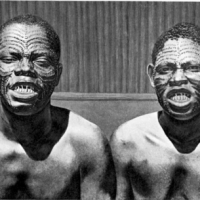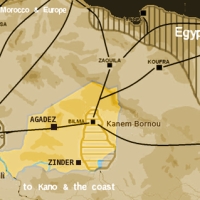
Cooking in a Congo kitchen for guests. Source: Davis-The Congo And Coasts Of Africa, 1907
As a follow-on to the last blog on Cassava, here, I want to give a little more information on the situation of cassava in Africa in the 19th Century, as described by English explorers of the time.
The fundamental importance of cassava as a mainstay across Africa is linked to its having replaced earlier, indigenous root and gourd crops, most of which were very difficult to process and/or difficult to digest. As well, to the fact that the leaves of cassava are used in making a highly nutritious relish that is called ‘sombé’ in central Africa – for a recipe of sombé see this blog:Sombé – Manioc Leaves & Goat Meat in a Hot Sauce
. For other positive (and negative) attributes of cassava, see the last blog, referred to above.
The following entries are by Sir Richard Burton, from his travels both in West and East Africa.
In the Delta of the Congo River, West Africa:
Manioc ripens between the sixth and ninth month, plantains and bananas once a year, cotton and rice in four months, and maize in forty days-with irrigation it is easy to grow three annual crops.
The travelling foods are mostly boiled batatas (sweet potatoes), Kwanga, a hard and innutritious pudding-like preparation of cassava which the ”Expedition*” (p.197) calls ”Coongo, a bitter root, that requires four days’ boiling to deprive it of its pernicious quality;” this is probably the black or poisonous manioc.
* He is referring to: Tuckey –Narrative of an Expedition to Explore the River Zaire, Usually Called the Congo, In South Africa in 1816, to which is added the Journal of Professor Smith. 1818.
From: Richard Burton – Two Trips to Gorilla Land and the Cataracts of the Congo. Vol.1 1876 [Trip = 1863]
At the last moment the men found that they had no ‘chop’, a franc produced two bundles of sweet manioc, god travelling food, as it can be eaten raw, but about as nutritious as Nowegian bark…
The cerials, however, are supplanted by plantains and manioc (cassava)…[which is] of the white variety, and, as at Lagos [Nigeria], the root may be called the country bread; I never saw the poisonous or black manioc, either in East or in West Africa, and I heard of it only once in Unyamweze, Central Africa. Yet it is mentioned by all old travellers, and the sweet harmlessvariety gives very poor “farinha,” Anglice “wood meal.”
From: Richard Burton – Two Trips to Gorilla Land and the Cataracts of the Congo. Vol.2 1876 [Trip = 1863]
On the caravan route from the Indian Ocean Swahili Ports to Lake Tanganyika (central Africa):
Burton arrives in Kaze (Kazeh) (central Tanzania), then a key caravan center for ivory and slaves that was maintained by Arab and Swahili merchants that could be called an incipient city-state – see this blog: Swahili city states: Pre-European ‘colonizers’ of East and Central Africa
After a day’s halt to collect porters at Yombo, we marched from it on the 20th of June, and passing the scene of our former miseries, the village under the lumpy hill, ” Zimbili,” we re-entered Kazeh. There I was warmly welcomed by the hospitable Snay bin Amir [a head Arab merchant in the trade], who, after seating us to coffee, as is the custom, for a few minutes in his barzah or ante-room led us to the old abode, which had been carefiilly repaired, swept, and plastered.
There a large metal tray bending under succulent dishes of rice and curried fowl, giblets and manioc [cassava] boiled in the cream of the ground-nut, and sugared omelets flavored with ghee and onion shreds, presented peculiar attractions to half-starved travelers.

The German coastal 'town' of Tang, East Africa. Kaze would have
looked similar to this.
Source: Davis-The Congo And Coasts Of Africa, 1907
Our return from Ujiji [the main caravan town on the shores of Lake Tanganyika] to Unyanyembe [region in Tanzania where Kaze was located] was thus accomplished in twenty-two stations [days], which, halts included, occupied a total of twentjr-six days, from the 26th of May to the 20th of June, 1858…
From: Richard Burton – The Lake Regions of Central Africa, A Picture of Exploration. Vol.2 1860


























Pingback: Cassava in Context: Views from the 19th Century, I of II « Dianabuja's Blog